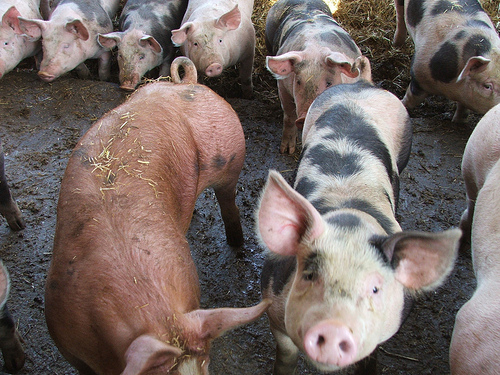By Nadine Moedt (The Cascade) – Email
Print Edition: October 10, 2012
Bacon lovers across North America are panicking after Britain’s National Pig Association announced that a global shortage of bacon and pork “is now unavoidable.” The association, cited on CBS News as “the voice of the British pig industry,” reported that the annual pig production in Europe has declined rapidly between 2011 and 2012. The bad news doesn’t stop there; world pig production has fallen in the same trend, possibly causing the doubling of pork prices by 2013.
The focus of this shortage ought not to be that we’ll be missing the beloved B from our BLTs, but rather that the worst drought in 50 years has hit the U.S. The drought has severely affected several important midwest farming areas in the States, such as Kansas, Iowa and Nebraska. According to the U.S. Drought Monitor (USDM), 75 per cent of Iowa, the nation’s biggest corn producer, is in a state of “extreme or exceptional drought.” Half the U.S. corn crop has been classified as being in “poor” or “very poor” shape according to the USDM.
Droughts do happen, and this one certainly isn’t the worse one to hit North America (remember the ‘30s?), so it’s not clear whether this is an absolute sign of global warming. According to the Intergovernmental Panel on Climate Change (IPCC), however, evidence does suggest that global warming will result in increased occurrences and intensity of droughts. The IPCC climate models tend to agree that droughts will get more intense and frequent in the Mediterranean, in central North America, Mexico, northeast Brazil and southern Africa. The exact regions are, as yet, still uncertain. If that change were to happen, the world would have to get its food from other sources.
The possible pork shortage is a great example for how such change could disrupt the world’s food supply. As corn and soybean prices rose due to the poor harvests, feed costs also rose. Pig farmers began to cut production and liquidate herds in an attempt to control losses due to their operating costs. Now imagine that cycle in a worldwide drought.
So how can we mitigate these effects? Solving the bacon shortage is relatively simple compared to solving global warming. NPA chairman Richard Longthorp in the National Post stated that supermarkets must “raise the price they pay Britain’s pig farmers or risk empty spaces on their shelves next year.” If we pay more now for bacon, according to the “Save Our Bacon” campaign, we can slow the slaughter of pigs, making both the pigs and the BLT-lovers happy.
Global warming is another issue altogether. We know by now that if we don’t drastically alter our actions environment-wise, we’re going to be in for a rough future. As the population rises and the world continues to heat up, it’s only going to get harder to maintain a sufficient food supply.
No bacon is one thing. Unfertile farmland and no food is quite another.


